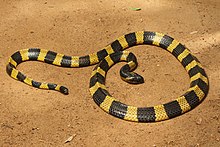| Bungarus | |
|---|---|

| |
| Bungarus fasciatus (banded krait), the largest species of krait | |
| Scientific classification | |
| Domain: | Eukaryota |
| Kingdom: | Animalia |
| Phylum: | Chordata |
| Class: | Reptilia |
| Order: | Squamata |
| Suborder: | Serpentes |
| Family: | Elapidae |
| Genus: | Bungarus Daudin, 1803 |
| Type species | |
| Bungarus annularis Daudin, 1803[1]
| |
| Synonyms[1] | |
Bungarus (commonly known as kraits /kraɪt/)[2][3] is a genus of venomous snakes in the family Elapidae. The genus is native to Asia. Often found on the floor of tropical forests in South Asia, Southeast Asia and Southern China, they are medium-sized, highly venomous snakes with a total length (including tail) typically not exceeding 2 metres (6 ft 7 in). These are nocturnal ophiophagious predators which prey primarily on other snakes at night, occasionally taking lizards, amphibians and rodents. Most species are with banded patterns acting as a warning sign to their predators. Despite being considered as generally docile and timid, kraits are capable of delivering highly potent neurotoxic venom which is medically significant with potential lethality to humans. The genus currently holds 18 species and 5 subspecies.